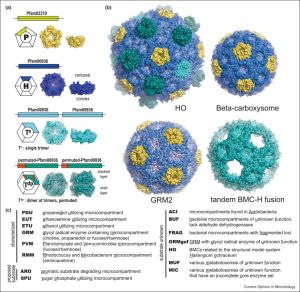Metabolosomes
Metabolosomes perform Protein Respiration, a form of Aerobic Respiration inferior to that of Mitochondria. It is the conversion of Glucose ![]() into ATP
into ATP ![]() with the use of Oxygen
with the use of Oxygen ![]() .
.
Requirements
No requirements
Processes
Protein Respiration: Glucose ![]() + Oxygen
+ Oxygen ![]() → ATP
→ ATP ![]() + Carbon Dioxide
+ Carbon Dioxide ![]()
A method of energy production, superior to that in Cytoplasm but inferior to Mitochondria. Requires a steady influx of Glucose ![]() . Rate scales with the concentration of environmental Oxygen
. Rate scales with the concentration of environmental Oxygen ![]() .
.
Modifications
No modifications.
Effects
No effects.
Upgrades
No upgrades.
Strategy
In many ways, Metabolosomes are an extension of Cytoplasm. A playstyle that works for the starting cell (LUCA) is likely to work for a cell built from Metabolosomes – simply gather Glucose ![]() from the environment. The difference is increased efficiency that can support more organelles with wider functions, such as Perforator Pili or Flagella.
from the environment. The difference is increased efficiency that can support more organelles with wider functions, such as Perforator Pili or Flagella.
However, natural Glucose ![]() concentrations in the environment decrease over the course of the game, so it may be advisable to switch to new food sources later on.
concentrations in the environment decrease over the course of the game, so it may be advisable to switch to new food sources later on.
Once a cell evolves a Nucleus, it's advisable to replace Metabolosomes with their eukaryotic equivalent, Mitochondria, since these are much more efficient.
Scientific Background
Unlike eukaryotes, prokaryote organelles do not have membranes. Instead, prokaryotes like bacteria construct compartments out of proteins. A Metabolosome is an example of such a compartment, officially referred to as a Bacterial MicroCompartment (BMC). BMCs consist of a polyhedral protein shell around 100-200 nm in size that looks similar to a virus capsid. The proteins that make up the shell typically have (semi-permeable) pores that allow different compounds (substrates and products) in and out of the organelle. They concentrate enzymes and proteins involved in specific metabolic processes in one spot, ensuring their success. The protein shell also acts as a physical barrier, allowing BMCs to conduct metabolic reactions that create toxic or unstable intermediate compounds.
Metabolosomes are a catabolic type of BMC, and are involved in the degradation of different carbon sources such as glycerol and amino acids. There is no clear evidence that the process of breaking down Glucose ![]() takes place in metabolosomes, however it is not unreasonable to assume that it could do so.
The actual process of breaking down glucose for energy takes place in several steps in both prokaryotes and eukaryotes. The only difference is where some of the enzymes are located and organized.
takes place in metabolosomes, however it is not unreasonable to assume that it could do so.
The actual process of breaking down glucose for energy takes place in several steps in both prokaryotes and eukaryotes. The only difference is where some of the enzymes are located and organized.
Read more on this organelle's Wikipedia page.

